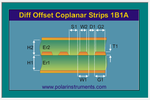tony_lth
Advanced Member level 5

- Joined
- Jul 28, 2010
- Messages
- 2,098
- Helped
- 377
- Reputation
- 756
- Reaction score
- 369
- Trophy points
- 1,363
- Location
- Beijing
- Activity points
- 12,727
Why the separation is twice times of the trace width?
For difference offset Coplanar strips,
If the trace width W1 is 60um.
Option1: S1=120um, D1=120um, then get Zdiff=90.99 ohms.
Option2: S1=300um, D1=300um, then get Zdiff=98.93 ohms.
Someone said that S1 and D1 should better be twice times of W1. So he denied option2 because of not 100 ohms diff impedance.
I think option2 is feasible, who can give comments on that? Attached Thumbnails
For difference offset Coplanar strips,
If the trace width W1 is 60um.
Option1: S1=120um, D1=120um, then get Zdiff=90.99 ohms.
Option2: S1=300um, D1=300um, then get Zdiff=98.93 ohms.
Someone said that S1 and D1 should better be twice times of W1. So he denied option2 because of not 100 ohms diff impedance.
I think option2 is feasible, who can give comments on that? Attached Thumbnails

